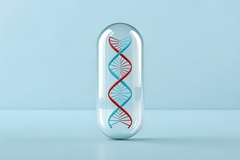Healthy aging no longer just for old: Pandemic delivers market staying power for young consumers

28 Jul 2022 --- Millennials and Gen Z are overturning the healthy aging space. Highlighting new realms of focus and driving industry innovation for fun formats, the segment now encompasses an array of age groups with companies diversifying ingredients, strategies and F&B to target broader demographics.
NutritionInsight speaks to experts from Biocell Technology, Kerry, Lonza, Gencor, Fonterra and Beneo on the primary demands and future trends shaping the space.
“Millennials are entering the category at an earlier age because of the COVID-19 pandemic. This is good news for the industry as consumers stay in a category like dietary supplements once they start purchases,” says Douglas Jones, global sales and marketing manager at Biocell.
Seismic market shift
Older consumers are no longer focused simply on living longer – they want to live better as well, explains John Quilter, vice president of Kerry’s ProActive Health portfolio.
Multiple factors contribute to the recent changes in trends within the healthy aging sector, underscores Kenny Suazo, marketing associate, Gencor. “People have an internal understanding that getting older doesn’t mean feeling old because ultimately aging healthy starts from within. However, it is evident that the biggest trend in the healthy aging space is the shift in demographics.”
The healthy aging industry has seen a growing shift from the ordinary older generation to now including Millennials and the Gen Z demographic, he adds. “Because of the new addition to the healthy aging space, the industry is subsequently generating products and marketing strategy changes that target a younger consumer in addition to the established audience.”
According to Lindsey Toth, director of global marketing, Lonza Capsules & Health Ingredients, the joint health market remains a dominating force in the nutraceuticals space and looks set to continue its impressive upward trajectory.
“The demand for joint health ingredients amongst consumers is subsequently at an all-time high. This was propelled, in part, by the pandemic, which fueled a seismic shift in activity levels and consumer habits. It was a period that has had a prolonged and profound impact on the way we move, behave and live, and it will likely have significant mobility and consumer health implications for years to come.”
Preventing illness is becoming a key trend in healthy aging.Trinity of consumer demands
In a bid to live an independent and active lifestyle, consumers are eyeing out cognitive function, healthy muscle, and joints to stay mobile, according to Mariko Hill, global innovations manager at Gencor Pacific. “They want to extend their youthfulness and reduce the gap between healthspan and lifespan to live more healthy years.”
Quilter adds that immune health has also proliferated interest, particularly since the onset of the COVID-19 pandemic. “We know that the immune system slows and weakens with age. Lifestyle changes, exercise and nutrition can help keep the body’s defenses in good shape, but there’s a growing demand for products that provide additional support.”
“Rather than looking for a ‘quick fix,’ consumers are now increasingly adopting a long-term approach to health maintenance, wanting to stay fit, active and independent until as late in life as possible,” underscores, Anke Sentko, vice president regulatory affairs and nutrition communication at Beneo.
For instance, more sedentary lifestyles caused by lockdowns saw weight gain and joint stiffness for some, while others dedicated time to becoming increasingly healthy to boost mental and physical wellbeing, she adds.
We do not see this category to experience any slowdown in sales,” Jones underscores. Young athletes, weekend warriors and busy parents are among the new demographics who are putting their joint health first.
Young athletes, weekend warriors and busy parents are among the new demographics who are putting their joint health first.
Investing in nutrition
Victoria Lam, general manager of marketing, Active Living, Fonterra, elaborates that healthy aging is no longer just about the elderly. “It is increasingly being viewed as an investment nurtured from a younger age and throughout life.”
“While the primary consumers in this space are still older people aged 55 to 70+ years, we are seeing a shift in interest from younger generations who are becoming more proactive and taking preventative actions to manage long-term health.”
The younger consumers recognize outcomes such as bone health and mobility are improved by lifestyle choices made across their life, not just in their senior years, and understand the value of nutrition in improving mobility across all ages, Lam notes.
“A diet that contains beneficial macronutrients and micronutrients can greatly enhance the likelihood of aging well. However, it can be difficult to ensure their nutritional intake reflects their requirements. Nutrient needs related to energy metabolism can reduce as the body ages, while the need for protein and many vitamins and minerals can increase,” Quilter explains.
A key example is a greater focus on building up bone density through their 20s and 30s (when bone mass peaks) in anticipation of the natural decline that comes with age, particularly for females who are more prone to osteoporosis post-menopause, Lam underscores.
Merging convenience and fun
According to Quilter, older consumers increasingly want convenient options that fit into their active lifestyles. “Grab-and-go beverages such as dairy and plant-based milk drinks, for example, can provide a protein hit after exercise. Gummies are also proving popular since they taste like an indulgence but still provide health benefits to allow consumers to feel virtuous.”
Jones explains a trend seeing growth is direct to mouth sachets products. Meanwhile, the younger age group, comprised of Millennials and Gen Z, require beverages which provide health benefits, as opposed to sodas to quench their thirst like previous generations did, Suazo elaborates.
“Healthy aging claims are starting to appear more regularly on food products and beverages as younger generations prefer functional food & beverages to classic supplement formats.”
Enjoyable consumption experience is one of key importance for consumers, Toth underscores. Novel forms such as gummies are growing in popularity, however, capsules still hold a dominant position in the market, she notes.
“Capsules also offer a lot of flexibility as a dosage form, making product innovation easily accessible for brands while delivering on consumer non-negotiables like convenience, swallowability, and efficacy.”
Broader focus
Beyond the demographic shift, Sentko highlights there has also been a significant change over the past ten years in what consumers seek out from their supplements.
“From a focus on chronic and acute diseases (such as cancer and heart disease) to lifestyle and aging. There is also growing understanding of how the potential of developing non-communicable diseases such as diabetes and being overweight or obese increases with age, and how such diseases and their onset can be influenced by diet and lifestyle-related changes.”
This has led to more and more consumers making the connection that managing blood glucose levels is a key way to help promote long-term health. With this in mind, blood sugar management is increasingly being linked to aging well, and F&B products that lower blood sugar levels are on the rise in this space, Sentko adds.
“Importantly, nutrition is beginning to play a key role in this. That is why the ‘aging well’ category has expanded over recent years to include products that help promote blood glucose management and digestive health, in addition to more traditional joint mobility and mental alertness focused solutions.”
By Andria Kades












